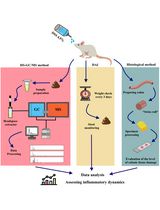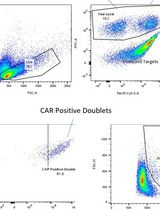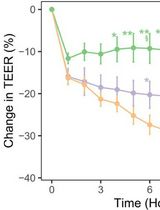- EN - English
- CN - 中文
Quantification of Neisseria meningitidis Adherence to Human Epithelial Cells by Colony Counting
通过菌落计数定量脑膜炎奈瑟菌对人上皮细胞的粘附能力
(*contributed equally to this work) 发布: 2018年02月05日第8卷第3期 DOI: 10.21769/BioProtoc.2709 浏览次数: 8189
评审: Chao JiangAndrea PuharAnonymous reviewer(s)

相关实验方案

HS-GC-MS 方法用于 DSS 诱导性结肠炎模型中 IBD 动态变化的诊断
Olga Yu. Shagaleeva [...] Natalya B. Zakharzhevskaya
2025年03月20日 1864 阅读
Abstract
To cause an infection, the human specific pathogen Neisseria meningitides must first colonize the nasopharynx. Upon tight interaction with the mucosal epithelium, N. meningitidis may cross the epithelial cellular barrier, reach the bloodstream and cause sepsis and/or meningitis. Since N. meningitidis niche is restricted to humans the availability of relevant animal models to study host-pathogen interactions are limiting. Therefore, most findings that involve N. meningitidis colonization derive from studies using cultured human cell lines. Human epithelial cells have been successfully used to examine and identify molecular effectors involved in initial adherence of the pathogen. Here, we describe a standard protocol to quantify the adherence of N. meningitidis to epithelial pharyngeal FaDu cells. Colony counts of cell lysates collected after infection are used to quantify adherence to the epithelial cells.
Keywords: Neisseria (奈瑟菌)Background
Upon entry to a new host, adherence to specific host tissues serves as an important step in bacterial pathogenesis. Molecular interaction between bacterial adhesins and receptors on the host cell surface determines colonization sites (Soto and Hultgren, 1999). The epithelial layer in the nasopharynx forms the first cellular barrier that the human restricted pathogen N. meningitidis encounters and colonizes asymptomatically. Tight adherence and interaction with the host cells can lead to penetration of the epithelium and entry into the bloodstream, resulting in life-threatening sepsis and/or meningitis (Stephens, 2009). Long filaments extending from the bacterial membrane, called type IV pili (Tfp), containing PilC1 tip-located adhesin play a key role in initial adherence of N. meningitidis to the nasopharyngeal epithelium (Marceau et al., 1995; Rudel et al., 1995). Tfp does not only promote interaction with host cells but is also involved in the development of bacterial aggregates, that can contribute to a high level of adherence and resistance against shear stress (Helaine et al., 2005; Mikaty et al., 2009; Engman et al., 2016). Apart from the Tfp, other surface expressed molecules like the opacity proteins, LPS, NadA, NhhA, App and MspA have been shown to affect the level of adhesion to the epithelial surface (Hill et al., 2010).
Animal models to study N. meningitidis colonization are limiting due to human host specificity. Consequently, the majority of the studies over the years have relied on cultured human cell lines (Merz and So, 2000). Here, we provide a step-by-step protocol adapted from Sigurlásdóttir et al. (2017) to quantify adherence of N. meningitidis to human epithelial pharyngeal FaDu cells in culture. In the following protocol, human epithelial cells are infected with both wild-type and an adhesion-deficient ΔpilC1 strain at a multiplicity of infection (MOI) of 10 for an incubation time of 4 h. The procedure described herein for N. meningitidis adherence to cultured epithelial cells could be easily applicable to a range of different bacterial species and cell lines with adaptation of the growth media (de Klerk et al., 2017).
Materials and Reagents
- Lab coat and protective gloves
- Marker pen
- Cell culture flasks T75 (SARSTEDT, catalog number: 83.1813.001 )
- Cell culture plates 24-well (SARSTEDT, catalog number: 83.1836 )
- Serological pipettes
2 ml pipette (SARSTEDT, catalog number: 86.1252.001 )
5 ml pipette (SARSTEDT, catalog number: 86.1253.001 )
10 ml pipette (SARSTEDT, catalog number: 86.1254.001 )
25 ml pipette (SARSTEDT, catalog number: 86.1685.001 )
- Sterile plastic loops
1 µl plastic loops (SARSTEDT, catalog number: 86.1567.050 )
10 µl plastic loops (SARSTEDT, catalog number: 86.1562.050 )
- Falcon tubes
15 ml tubes (SARSTEDT, catalog number: 62.554.502 )
50 ml tubes (SARSTEDT, catalog number: 62.547.254 )
- Pipette tips
20-200 µl capacity (SARSTEDT, catalog number: 70.760.502 )
50-1,000 µl capacity (SARSTEDT, catalog number: 70.762.100 )
- 5 µm pore filter (VWR, catalog number: 514-4106 )
- Cell culture plates 96-well (SARSTEDT, catalog number: 83.3924 )
- Bacteriological Petri plates, 92 x 16 mm (SARSTEDT, catalog number: 82.1473 )
- 5 ml syringe (VWR, catalog number: 613-3940 )
- 250 ml vacuum filtration unit, 0.22 μm (SARSTEDT, catalog number: 83.1822.001 )
- Bacterial strain: Neisseria meningitidis serogroup C strain FAM20 wild-type and ΔpilC1 (Rahman et al., 1997). The bacterial strain FAM20 is a nalidixic acid-resistant mutant of FAM18 that is available at ATCC (ATCC, catalog number: 700532 )
Note: The bacterial stocks are stored in 25% glycerol:75% GC liquid medium (see Recipes) at -80 °C.
- Cell line: pharyngeal epithelial cell line FaDu (ATCC, catalog number: HTB-43 )
Note: The cell line is stored in 90% FBS:10% DMSO at -140 °C.
- 70% ethanol
- Glycerol (Sigma-Aldrich, catalog number: G5516 )
- DMEM high glucose, GlutaMAXTM Supplement, pyruvate (Thermo Fisher Scientific, catalog number: 31966047 )
- Fetal bovine serum (FBS), heat inactivated (Sigma-Aldrich, catalog number: F9665 )
- Dimethyl sulfoxide (DMSO) (Sigma-Aldrich, catalog number: D8418 )
- Phosphate-buffered saline (PBS), 10x concentrated (Statens Veterinärmedicinska Anstalt, catalog number: 992442 )
- GC agar medium base (NEOGEN, Acumedia, catalog number: 7104A )
- D-glucose (Sigma-Aldrich, catalog number: G8270 )
- L-glutamine (Sigma-Aldrich, catalog number: G8540 )
- Ferric nitrate (Sigma-Aldrich, catalog number: F3002 )
Note: This product has been discontinued.
- Cocarboxylase (Sigma-Aldrich, catalog number: C8754 )
- Saponin (Sigma-Aldrich, catalog number: S7900 )
- Protease peptone (Oxoid, catalog number: LP0085 )
- Starch, soluble (Sigma-Aldrich, catalog number: S9765 )
- Potassium phosphate dibasic (Sigma-Aldrich, catalog number: 60353 )
- Potassium phosphate monobasic (Sigma-Aldrich, catalog number: 60218 )
- Sodium chloride (Sigma-Aldrich, catalog number: S3014 )
- Trypsin-EDTA (0.5%), no phenol red, 10x (Thermo Fisher Scientific, GibcoTM, catalog number: 15400054 )
- GC agar plates (see Recipes)
- Kellogg’s supplement (see Recipes)
- Cocarboxylase solution (see Recipes)
- 2x trypsin (see Recipes)
- 1% saponin (see Recipes)
- Phosphate-based GC liquid medium (see Recipes)
Equipment
- Class II biosafety cabinet (e.g., Esco Micro, model: Airstream® Max )
- Incubator at 37 °C and with a 5% CO2 environment (e.g., Thermo Fisher Scientific, Thermo ScientificTM, model: HeracellTM 150i )
- Cell culture hood (e.g., ESCO laminar flow cabinet, Esco Micro, model: Airstream® Gen 3 )
- Inverted microscope (e.g., Carl Zeiss, model: Axiovert 40 C )
- Spectrophotometer (e.g., Bio-Rad Laboratories, model: SmartSpec Plus )
- Hemocytometer (e.g., VWR, catalog number: 631-0923 )
- Pipette boy (e.g., Fisher Scientific, model: Fisherbrand Electric Pipet Controller )
- Pipettes
10-100 µl capacity (e.g., Eppendorf, catalog number: 4924000053 )
100-1,000 µl capacity (e.g., Eppendorf, catalog number: 4924000088 )
- Multichannel pipette, 10-100 µl capacity (e.g., Eppendorf, catalog number: 3125000036 )
- Water bath set to 37 °C (e.g., Grant Instruments, model: Sub Aqua Pro, catalog number: SAP12 )
- Centrifuge
- 1 L flask
- Autoclave
Procedure
文章信息
版权信息
© 2018 The Authors; exclusive licensee Bio-protocol LLC.
如何引用
Sigurlásdóttir, S., Saroj, S. D., Eriksson, O. S., Eriksson, J. and Jonsson, A. (2018). Quantification of Neisseria meningitidis Adherence to Human Epithelial Cells by Colony Counting. Bio-protocol 8(3): e2709. DOI: 10.21769/BioProtoc.2709.
分类
微生物学 > 微生物-宿主相互作用 > 细菌
细胞生物学 > 基于细胞的分析方法 > 细胞粘附
您对这篇实验方法有问题吗?
在此处发布您的问题,我们将邀请本文作者来回答。同时,我们会将您的问题发布到Bio-protocol Exchange,以便寻求社区成员的帮助。
提问指南
+ 问题描述
写下详细的问题描述,包括所有有助于他人回答您问题的信息(例如实验过程、条件和相关图像等)。
Share
Bluesky
X
Copy link










